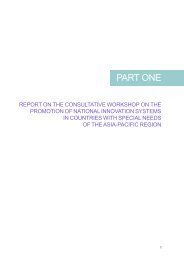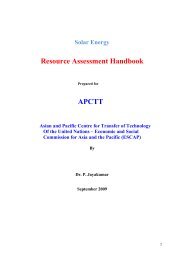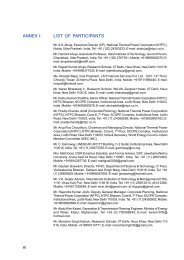Download Complete PDF - apctt
Download Complete PDF - apctt
Download Complete PDF - apctt
- No tags were found...
You also want an ePaper? Increase the reach of your titles
YUMPU automatically turns print PDFs into web optimized ePapers that Google loves.
step, the domestic manufacturing obligations on the line of bulk tendering carriedout by NTPC for 800/660 MW sets could be stipulated for the power projects beingawarded for the benefit of the 13 th FYP (2017-2022). Such a step will ensure thatindigenous vendor development is facilitated for high-tech supplies in the future.4. Role of various agenciesPolicy measures for equity participationThe Insurance Regulatory and Development Authority (IRDA) and the Pension FundRegulatory and Development Authority (PFRDA) need to consider modifying their policyframework so as to channelize long-term funds available with insurance companiesand pension (provident) fund organizations. Profit-making central and state utilities inpower generation, transmission and distribution – such as NTPC, NHPC, POWERGRIDand NHDC Limited – should be encouraged to offer their company shares via the stockmarket.Sector-specific fundsThe Government of India introduced sector-specific funds with the specific objectivesof making funds available to a particular sector under respective funds. Some of thesefunds considered potential source of finance for the power sector are:• Specialized debt funds for infrastructure financing;• Creation of specialized long-term debt funds to cater to the needs of the infrastructuresector; and• A regulatory and tax environment suitable for attracting investments is the key forchannelizing long-term funds into infrastructure development. RBI has been askedto look into the feasibility of not treating investments by banks in such closeendeddebt funds as capital market exposure. IRDA may consider including investmentin registered debt funds as approved investments for insurance companies.Policy measures for take-out financing for ECB lendersRBI has stipulated guidelines for take-out financing through ECB policy. The guidelinesspecify that corporates developing infrastructure projects (including power projects)should have a tripartite agreement with domestic banks and recognized overseas lendersfor conditional or unconditional take-out of the loan within three years of the scheduledcommercial operation day. As the market conditions cannot be predicted, a window of6-12 months is suggested. Further, the guidelines stipulate that the loan should havea minimum average maturity period of seven years. It is suggested that the minimumaverage maturity period stipulated should be aligned to maturity profiles of ECB aboveUS$20 million and up to US$500 million – that is, minimum average maturity of fiveyears as stipulated in RBI Master Circular.IIIPOTENTIAL FOR INTERNATIONAL COOPERATIONSignificant understanding at the international level would be necessary to ensure thatglobal cooperation helps reduce the carbon intensity in power generation. International74







